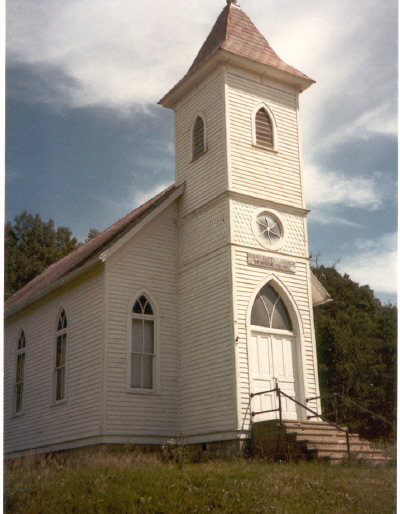|
T.103-104N.-R.5W.

Photo of the Mound Prairie Church
taken by John Stallings, III
From, "The History of Houston
County", Taylor Publishing, 1982
There are conflicting claims as to the
personnel and the date of the first settlement of Mound Prairie. The name
of the township was suggested by Dr. Chase in
remembrance of the remarkable rounded bluff in section four, surrounded by a
wide valley on all sides. This was originally a part of Union and La
Crescent. The first town meeting of which there is a record, was at the
house of Jesse Hewitt in April 1860. Isaac
Holmes was moderator, and the first officers chosen were:
Supervisors, George Cannon, chairman, Jacob
Bush and George Larson; assessor, Jacob
Kroehler; town clerk, Wm. Connington;
treasurer, Seth Lore, and superintendent of
schools, Andrew Orr.
A heavy growth of black walnut timber
along the Root River, which could be cut and rafted down to the Mississippi,
attracted those making temporary claims, followed by the supplementary land
office operators, early in the 1850's. The first claim was John
Crypts, followed by Thomas Van Sickle in
1852. Van Sickle sold his claim in section 21 to James
C. Day who, in a few years, sold it to Mr. P. Eberhard. Jacob
Bush had a claim on section 26.
Philip G. Vix,
a native of France, came from Wisconsin in 1854 locating on section 29. Edward
S. Lore arrived in 1855, locating on North Ridge, later joined by his
father, Seth Lore, who subsequently constructed and
operated the Lorette House until 1861 on the old territorial road from La Crosse
to St. Paul.
In 1856 Dr. J. G.
Sheldon located on section 33. He had a village surveyed and
platted, and bestowed upon it the Castilian name of "San Jacinto."
It was on Wm. Hunter's land later purchased by Wm.
Orr, Sr. The San Jacinto and Lorette post-offices were discontinued
in 1869, and the office established at Mound Prairie store with J.
A. Eberhard in charge. It remained there until the store was closed
in the 1950's under the direction of Wm. Blumentritt.
The Southern Minnesota Railroad Company,
later to become the Milwaukee Railroad, ran in the valley of the Root River, but
was abandoned in 1981.
The township has always been
predominantly agricultural with some periodic lumbering, but in the 1960's and
1970's The Valley High Country Club with about thirty residences has been
developed in section 3.
The present 1982 township officers are: Phillip
Eberhard, clerk; Ed. Schumacher, treasurer; Ralph
Schild, Donald Boldt, and Francis
Von Arx, supervisors.
Submitted by Ivy
McCune
You
are visitor  since this counter was added July 13, 2003.
since this counter was added July 13, 2003.
|
 |